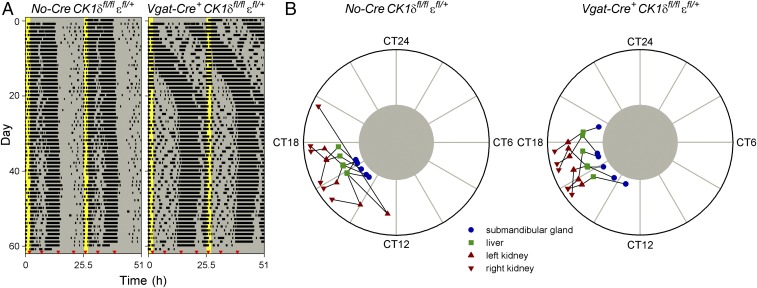Fig. 6.
Entrainment to a 2-h light/23.5-h dark lighting cycle induces a similar state of internal desynchrony in Discordant and Cre-negative control mice. (A) Representative, double-plotted wheel-running actograms of Cre-negative control (No-Cre CK1δfl/fl εfl/+ Per2::Luc/+) and Discordant (Vgat-Cre+ CK1δfl/fl εfl/+ Per2::Luc/+) mice housed in a 2-h light/23.5-h dark lighting cycle. This 25.5-h T-cycle entrained both genotypes, with the active phase uninterrupted by light. The light and dark phase are indicated by the yellow and gray background, respectively. The timing of in vivo PER2::LUC-bioluminescence imaging sessions is indicated by red triangles. (B) Peripheral organ in vivo PER2::LUC-bioluminescence peak-phase plots for Cre-negative control (Left) and Discordant (Right) mice. PER2::LUC bioluminescence in peripheral organs peaked at the same phase of the behavioral cycle in both Discordant and Cre-negative control mice. The timing of peak PER2::LUC bioluminescence is depicted separately for each of the four organs, with black lines connecting different tissues of the same animal. The timing of peak PER2::LUC bioluminescence is shown relative to the timing of behavior (as indicated by the circadian time scale) to ease the comparison of the internal desynchrony state between genotypes, even though the mice were exposed to a lighting cycle. CT, circadian time.

